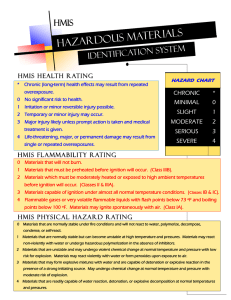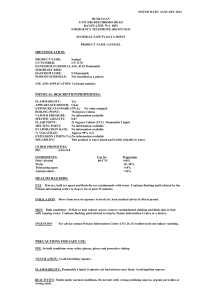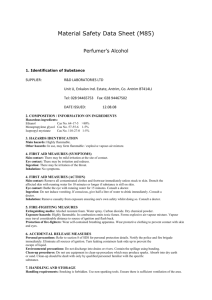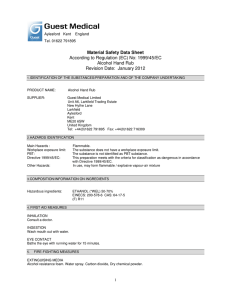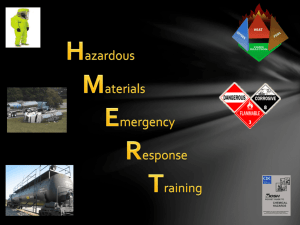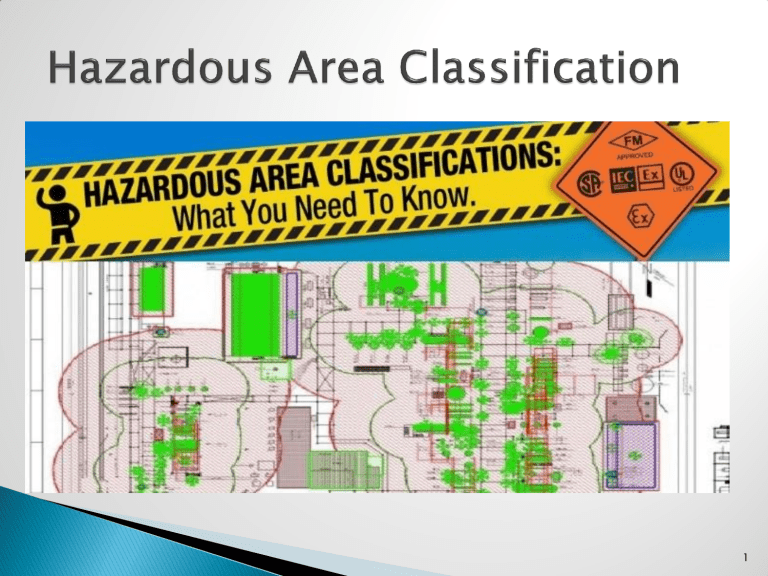
1 At the beginning, let’s review some basic definitions 2 Hazard Something with the potential to cause harm such as FIRE Hazard Risk The probability of that harm to occur and it’s consequences. 3 Fire A combustion reaction in which fuel is converted to combustion products in the presence of oxygen rapidly producing heat and light. 4 Explosion A sudden release of energy causing a pressure blast wave. Usually it is the result, not the cause, of a sudden release of gas under high pressure. 5 Ignition sources Open flames – matches, welding, etc. Electrical sparking. Spontaneous ignition. Static electricity. Hot surfaces. Smoking. 6 7 The stages of combustion 8 Flash Point The lowest temperature of a liquid at which sufficient vapor is given off to ignite momentarily (flash), when an external source of ignition is applied. Note the difference between Diesel & Petrol 9 Some common solvents and their flash points 10 Fire Point The lowest temperature of a liquid at which sufficient vapor is given off at the surface that the application of an external ignition source will lead to continuing burning. The fire point temp. is usually just above the flash point. 11 Auto-Ignition temperature (AIT) The lowest temperature at which the substance will ignite without the application of an external ignition source. No requirement of external ignition source to achieve combustion as Methane gas has an auto-ignition temp. of 580 °C 12 Limits of Flammability The extremes of fuel (vapor or gas) to air rations between which the mixture is combustible 13 Examples of Flammable Limits 14 How to prevent and mitigate Explosions? Ventilation Ignition sources Containment VICES Exchange Separation 15 Ensure that any vapors given off from a spill, leak, or release from any process will be rapidly dispersed, preventing the formation of a vapor/air mixture above the LEL. 16 Ignition sources must be removed from storage and process areas of flammable materials. If the ignition source generates energy above the Minimum Ignition Energy (MIE) for the flammable vapor or gas an explosion will occur. 17 Prevents the escape of flammable materials into the workplace which can release vapors and generate explosive mixture. 18 Exchange of a flammable substance for a less flammable one will reduce the risk of formation of an explosive atmosphere under normal working conditions. 19 Separation of flammable substances from other processes and general storage areas by physical barriers, walls or partitions will contribute to a safer workplace by controlling the zone in which flammable atmosphere may be present. 20 Source of Release A point from which a flammable gas, vapors or liquids may be released into atmosphere Such as : flanges, vents, instrument connections…etc. 21 22 Ignition source 23 We have now source of release and source of ignition. What is missing for a fire to occur ?? 24 To avoid ignition of releases that may occur from time to time The approach is to reduce (to an acceptable level) the probability of coincidence of a flammable atmosphere and an electrical or other source of ignition. 25 A three dimensional space in which a flammable atmosphere may be expected to be present at such frequencies as to require special precaution for the design and construction of equipment, and the control of potential ignition sources. Leak source 26 Where is the Leak & Ignition Sources here ? 27 Subdivisions of Hazardous Area The European classification Zone 0 – Zone 1 – Zone 2 The American classification Division 1 – Division 2 28 Zone 0: flammable atmosphere is continuously present or present for long periods. Zone 1: flammable atmosphere is likely to occur in normal operation. Zone 2: flammable atmosphere is unlikely to occur in normal operation and, if it occurs, will exist only for short period. 29 Grade of Release Continuous: nearly so. A release that is continuous or Primary: A release that is likely to occur periodically or occasionally in normal operation. (Vents, Sample points, etc) Secondary: A release that is unlikely to occur in normal operation and, in any event, will do so only infrequently and for short periods. (Flanges, Instrument connections, etc) 30 Zones and Divisions 31 Example NEC 500-503 NEC 505 CLASS I (Gases and Vapors) Acetylene Hydrogen Ethylene Propane Group A Group B Group C Group D IIC IIC or IIB+H2 IIB IIA CLASS II (Dusts) Metal dust Coal dust Grain dust Group E Group F Group G CLASS III (Fibers & Flying) Wood, paper or cotton processing. No sub-groups 32 An area where Flammable Gases or Vapors are or can be present in the air in quantities sufficient to produce explosive or ignitable mixtures. Examples : Petroleum Refineries, Gasoline storage and dispensing areas, Dry cleaning plants, Spray Finishing areas, utility gas plants. 33 34 An area where presence of Combustible Dust present a fire or explosion hazard. For example: Grain elevators, flour and feed mills, Use or store of magnesium or aluminum powders, producers of plastics, fireworks. 35 36 An area made hazardous due to the presence of easily Ignitable Fibers or flings. For example: Textile mills, cotton gins, cotton seed mills, plants that shape or cut wood and create sawdust or flings. 37 38 In addition to the types of hazardous locations, the kind of conditions under which these hazards are present are very important : Normal Conditions & Abnormal Conditions Division 1: Normal Conditions Division 2 : Abnormal Conditions 39 Class I Division 1 II 2 III 40 Where ignitable concentration of flammable gases, vapors or liquids can exist all of the time or some of the time under normal operating conditions. (Remember Zone 0 & Zone 1) Where ignitable concentrations of such gases or vapors may exist frequently because of repair or maintenance operations or because of leakage. Faulty operations of equipment or processes might release ignitable concentrations of flammable gases or vapors and might cause simultaneous failure of electrical equipment in such a way as to directly cause the electrical equipment to become a source of ignition. 41 Is a location in which volatile flammable liquids or flammable gases are handled, processed, or used, but in which the liquids, vapors, or gases will normally be confined within closed containers or closed systems from which they can escape only in case of accidental rupture or breakdown of such containers or systems or in case of abnormal operation of equipment. Remember Grades of Release and Zone 2 definition 42 43 44 45 46 The gases and vapors of class I locations are broken into four groups : A, B, C, and D. These materials are grouped according to the ignition temperature of the substance, its explosion pressure, and other flammable characteristics. 47 48 Group A An atmosphere containing Acetylene. Group B Atmosphere containing a flammable gas, a flammable liquid produced vapor, or a combustible liquid produced vapor mixed with air that may burn or explode, such as Hydrogen or fuel and combustible process gases containing more than 30% hydrogen by volume - or gases of equivalent hazard such as butadiene, ethylene oxide. 49 Group C Atmosphere containing a flammable gas, a flammable liquid produced vapor or a combustible liquid such as carbon monoxide, ether, hydrogen sulfide, Morphline, cyclopropane, ethyl, isoprene, Acetaldhyde and ethylene or gases of equivalent hazard. 50 Group D Atmosphere containing flammable gas, flammable liquid produced vapor, or combustible liquid produced vapor mixed with air that may burn or explode, such as gasoline, acetone, ammonia, benzene, butane, ethanol, hexane, methanol, methane, vinyl chloride, natural gas, naphtha, propane or gases of equivalent hazard 51 It is important to know how hot equipment gets, so that hot surfaces cannot be ignition sources. Six temperature classes are used T1 – T6 The lower the number the higher the maximum allowable surface temperature Temperature classification is based on fault conditions. T-class must be below Auto-ignition Temperature of the gas. 52 Temperature Class is assigned to flammable material based on its auto-ignition temperature. (Remember the definition) 53 54 55 1- Zone in which the equipment will be used. 2- Sensitivity to ignition of the material likely to be present, expressed as a gas group. 3- Sensitivity of the material present to ignition by hot surfaces, expressed as a temperature class. 56 Equipment suitable for Zone 0 can be used in Zones 0, 1 or 2. Equipment suitable for Zone 1 can be used in Zones 1 or 2. Equipment suitable for Zone 2 can be used only in Zone 2. 57 Grouping becomes more severe in going from IIA to IIB to IIC. Group IIB equipment may be used in place of Group IIA equipment. Group IIC equipment can be used in place of equipment for both Group IIA and IIB. 58 59 60 61 1. 2. 3. 4. 5. 6. 7. 8. 9. Flameproof Enclosures “d” Intrinsic Safety “i” Increased Safety “e” Powder/Sand Filled “q” Pressurized Apparatus “p” Oil Immersion “o” Special Protection “s” Encapsulation “m” Type of protection N “N” 62 Type of protection, for which the parts which can ignite an explosive atmosphere are inside an enclosure which will Withstand the pressure of the Explosion within the enclosure. Prevent the transmission of the Explosion to an explosive Atmosphere surrounding the Enclosure. 63 Type of protection, for which the energy in the electrical circuit is held so low that sparks, arcs or temperatures capable of causing ignition cannot occur. Includes sub-division into the categories ia & ib ia must not produce any ignition when any combination of two faults is present. ib must not produce any ignition, in normal operation, when one fault is present. 64 Type of protection, for which measures are taken to prevent the possibility of nonpermissible high temperatures and the formation of sparks or arcs on inner or outer parts of electrical apparatus, on which these do not occur in normal operation, with an increased level of safety. 65 The electrical apparatus enclosure is filled with powder or sand. An arc occurring in the enclosure does not ignite an explosive atmospheres surrounding the enclosure. 66 Preventing the entry of surrounding atmosphere into the enclosure by holding an ignition-protection gas (air, inert gas) under over-pressure in relation to the surrounding atmosphere. 67 Electrical apparatus or parts thereof are made safe by immersion in oil such that potentially explosive atmosphere above the surface of the oil or outside the enclosure will not be ignited. 68 Ingress protection ratings or IP ratings, refer to the level of protection offered by an electrical enclosure, against solids and liquids. In an environment where dust or water could damage electronic components, a sealed enclosure is used to prevent such ingress and safe house the electronics. They are commonly used for applications which may be exposed to the elements, as well as dust or moisture. Typical industries include marine, offshore oil and gas platforms, lighting, food processing and more. 69 70 71 Gas, Vapors, Dusts….?? Hydrogen, LPG, Gasoline ?? 72 Identify sources of release and determine grade of release. and hence Zone 0 – Zone 1- Zone 2 or Division 1, 2 73 API RP 500 shows typical examples of classifications of equipment in oil and gas production facilities, including the extent of the classified areas around such equipment. 74 Gas Groups : A, B, C, D OR IIA, IIB, IIC Temp. classes from T1 to T6 75 76 77 78 A. Oxygen, Wood, CO2 B. Oxygen, Fuel, CO2 C. Oxygen, Fuel, Nitrogen D. Oxygen, Fuel, Heat 79 A. Activate the Alarm B. Ask someone else what to do C. Run away as quickly as possible D. Get a fire extinguisher 80 A. Pass by the fire, activate the sprinkler system, seal fire area from oxygen, stop unauthorized entry. B. Pull the alarm, alert the response team, shut down the power sources, secure the area. C. Pass by the fire, activate the fire alarm, select the proper extinguisher, shoot at the base of the fire. D. Pull the pin, aim at the base of the fire, squeeze the handle, and sweep at the base of the fire. 81 A. Class A (solid materials like wood, paper, textiles) B. Class B (liquids like petrol, diesel or oils) C. Class C (gasses) D. All the above 82 a. Boiling Point. b. Auto Ignition Temperature. c. Flash Point. d. Fire Point. 83 a. Be documented b. Documentation will be available c. Classification under supervision of qualified registered engineer d. All the above 84 a. Class I b. Class II c. Class III d. Hazardous 85 a. Class 1 b. Class 11 c. Class 111 d. Hazardous 86 a. True b. False 87 a. Class I, Division 1 b. Class II c. This is not considered a hazardous location d. Class I, Division 2 88 a. True b. False 89 a. intrinsically safe b. approved or safe for the hazardous (classified) location c. waterproof d. Both a and b 90 a. Zone 0 b. Zone 1 C. Zone 2 d. Zone 3 91 92 93 94 95

